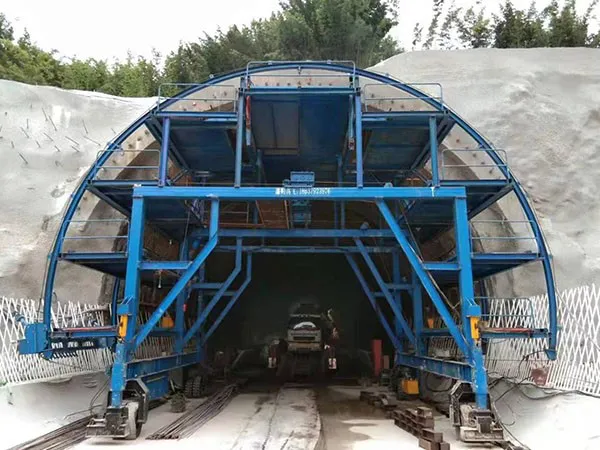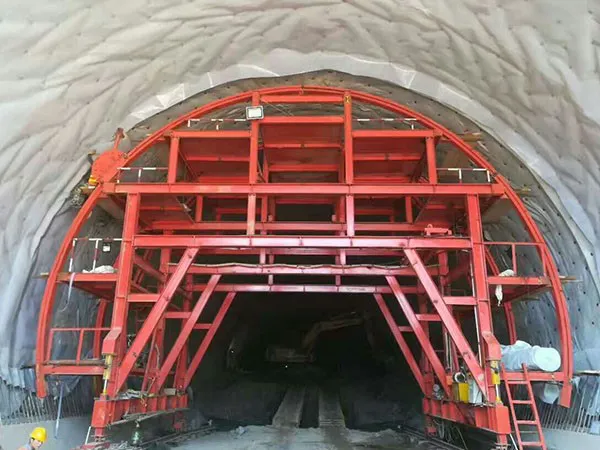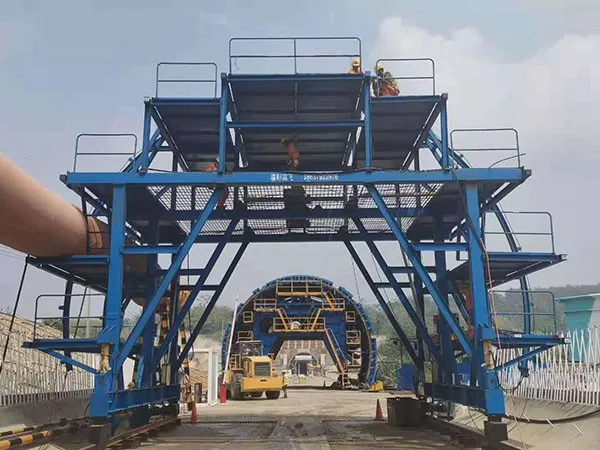Lining trolleys, primarily used in tunnel construction for the secondary lining process, are critical pieces of equipment that ensure the quality, efficiency, and safety of concrete lining. Their design specifications are complex and tailored to the specific demands of tunneling projects.

Before diving into specifications, it's crucial to understand the fundamental roles and variations of lining trolleys:
Primary Function: To support the formwork (shuttering) for cast-in-place concrete linings, or to position and install precast concrete segments for the inner wall of a tunnel. They help achieve the required surface shape, size, and finish of the tunnel lining.
Types (based on functionality, tunnel shape, and construction method):
Cast-in-Place (CIP) Trolleys: Most common, these carry large steel formwork sections. Concrete is pumped behind the formwork, and once cured, the trolley strips the formwork and moves to the next section.
Full-Round Formwork Trolley: For circular or near-circular tunnels, supporting the entire cross-section (invert, walls, arch).
Arch (or Crown/Sidewall) Formwork Trolley: For horseshoe or D-shaped tunnels, where the invert is cast separately.
Telescopic Formwork Trolley: Sections retract inwards for efficient movement through previously cast lining.
Precast Segmental Lining Trolleys (Segment Erectors): Used in TBM (Tunnel Boring Machine) tunnels, they transport, position, and install precast concrete segments.
Self-Propelled vs. Towed: Some have their own drive systems, others are moved by external machinery.
Rail-Mounted vs. Wheeled: Depending on the tunnel floor conditions and required stability.

The design of a lining trolley must balance structural integrity, operational efficiency, adaptability, and safety.
Structural Strength, Stiffness, and Stability:
Load Bearing: The trolley and its formwork must withstand immense lateral and vertical pressures from wet concrete during pouring. Finite Element Analysis (FEA) is commonly used to simulate these loads and verify the structural integrity, ensuring minimal deformation that would affect concrete quality. Maximum stress and deformation values are critical parameters (e.g., maximum stress of 168 MPa and deformation of 4.9 mm have been found to be acceptable in some designs).
Material Selection: Steel is the primary material, with specific grades and thicknesses for components like panels (e.g., 14mm steel plate for panels, 12mm for waist plates, reinforced with channel steel and angle steel for arches and sides).
Overall Rigidity: The entire structure, including the gantry and formwork, must maintain its shape and position under working conditions.
Transport Conditions: Components should be designed for ease of transportation to and within the tunnel.
Formwork Design and Dimensions:
Tunnel Section Compatibility: The external dimensions and shape of the formwork must precisely match the required tunnel cross-section (circular, horseshoe, rectangular, or custom).
Shape Error Tolerance: Strict tolerances are imposed to ensure a smooth and accurate lining surface. For example, for a section radius R≤3m, the error should be no more than 10mm; for R>3m, no more than 20mm.
Alignment: The formwork's center must coincide with the tunnel's centerline. The trolley typically includes transverse shifting mechanisms to adjust for deviations (e.g., ±150mm horizontal movement).
Module Length: General formwork lengths range from 6m to 12m, influenced by tunnel turning radius and overall construction organization.
Joint Tightness and Surface Finish: Formwork joints must be tight to prevent concrete leakage and ensure a smooth, defect-free concrete surface (no honeycomb, spot, or misalignment defects).
Operating Features: Inclusion of operating windows, grouting holes, and provisions for vibrating systems and arch void monitoring.
Demolding Mechanism: Efficient and reliable systems for supporting, demolding, and locking the formwork, often hydraulically driven for support and demolding, and mechanically for locking.
Mobility and Adjustment Systems:
Traveling Mechanism: Enables the trolley to move along the tunnel. This can be rail-mounted, wheeled, or self-propelled.
Hydraulic System: Crucial for precise control of formwork adjustment (lifting, lowering, traversing), segment handling, and jacking. Parameters like jacking cylinder stroke (400mm) and side cylinder stroke (360mm) are specified.
Transverse/Longitudinal Adjustment: Mechanisms for precise positioning and alignment with the tunnel axis.
Gantry Design: Often features a large gantry structure that can be raised and lowered independently, with front and rear columns and large-stroke lifting mechanisms.
Support System: Prevents inward shrinkage and deformation of the formwork under concrete pressure. Adjustable and detachable supports are often required.
Operational Efficiency and Automation:
Construction Speed: The design aims to maximize lining construction speed to keep pace with tunnel excavation.
Automation and Intelligence: Modern trolleys incorporate intelligent systems for concrete pouring and distribution, vibrating, arch void monitoring, and formwork grouting. This allows for visualization, informatization, and intelligence in the lining process, reducing manual labor and improving quality.
Humanization: Designs increasingly focus on reducing labor intensity and improving the working environment for operators.
Multi-segment Hinged Formwork: Allows for efficient handling and deployment, ensuring strength without relying solely on gantry support.
Safety and Maintainability:
Braking System: Essential for safe movement and positioning, particularly for self-propelled units and during concrete pouring.
Ergonomics and Usability: Design should improve operator ergonomics and the general usability of the system.
Maintenance Access: Components should be designed for easy maintenance and adjustment.
Standardization: Use of standard parts to promote versatility and improve utilization rates.

Skeleton-Free, Traversing Trolleys: New designs aim to reduce reliance on dense supporting rods, freeing up space and reducing work intensity.
Intelligent Lining Trolleys: Integration of advanced control systems, sensors, and data feedback for automated processes, precise control, and real-time monitoring of pouring parameters and structural performance.
Finite Element Analysis (FEA): Increasingly used during the design phase to simulate various loading conditions and optimize the structural design for strength, stiffness, and material efficiency.
Modular Design: Facilitates assembly, disassembly, and adaptation to different tunnel sections and project requirements.
In conclusion, the design specifications for lining trolleys are comprehensive, driven by the demanding environment of tunnel construction. They emphasize robust structural integrity, precise dimensional control, efficient operational mechanisms (often hydraulic), and increasingly, intelligent automation to enhance quality, speed, and safety.
Gaofei
Address: 200m east of tulip garden, group 12 of zhangling community, hongshan street office, hongshan town, xigong district, Luoyang
Tel: +8616638856888
Contact: Gaofei Huang
Mobile: +86-18637923976
Phone: 0379-80881719/ 0379-60162687
QQ: 286827457
E-mail: gaofei@gf-bridge-tunnel.com